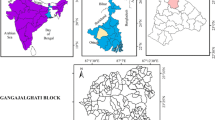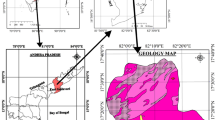Abstract
In the present paper, various groundwater potential zones for the assessment of groundwater availability in a hard rock terrain have been delineated with the help of hydrogeological parameters using satellite IRS- 1B-LISS-II digital data. Area selected for this study is a part of Bargarh district, Orissa, India covering an area of about 680 square km. Satellite data has been used to prepare geological-cum-lineaments, geomorphological, landuse and drainage maps. The various thematic maps have been integrated with the help of Geographic Information System to demarcate the poor to excellent groundwater potential zones. Weightage has been given to various groundwater controlling factors to the total groundwater potential in each segment of study area. Subsequently, several sites were selected and pumping tests carded out in the area. The results show that among others, lineaments as well as drainage density are the most important contributory factors in the groundwater potential of various geomorphic units in the area of investigation.
Similar content being viewed by others
References
Bonham-Carter G F (1994). Geographic Information Systems for geoscientists: Modelling with GIS. Elseviers Science Ltd., 398 p.
Chatterjee RS and Bhattacharya AK (1995). Delineation of the drainage pattern of a coal basin related inference using satellite remote sensing techniques. Asia Pacific Rem Sen J, 1, 107–114.
Erdas (1996). Erdas field guide, (4th Edition), Erdas Inc., Atlanta, USA. 654 pp.
Geological Survey of India (1979). Geological Survey of India map printing division, Hyderabad, India, F-44R.
Horton RE (1945). Erosional development of streams and their drainage basins: Hydrophysical approach to quantitative morphology. Geol. Soc. Am. Bull. 56: 275–370.
Jensen JR (1986). Introductory digital image processing. Prentice Halls, Englewood Cliffs, NJ, 339 p.
Mather Paul M (1987). Computer processing of remotely sensed images: An Introduction. John Wiley & Sons, NY, 352 p.
Ravindran KV (1997). Drainage morphometry analysis and its correlation with geology, geomorphology and ground water prospects in Zuvari basin, South Goa, using remote sensing and GIS.Proc. Nal Sym -Remote sensing for natural resource with special emphasis on water management, held at Pune during Dec. 4-6,1996, pp 270–296.
Sar SN (1991). A report on Ground water resources and developmental potential of Sambalpur District, Orissa. Central Ground Water Board, Ministry of Water Resources, Government of India, 39p.
Sharma D and Jugran DK (1992). Hydromorphogeological studies around Pinjaur-Kala Amb area, Ambala district (Haryana), and Sirmur district (Himanchal Pradesh). J. Indian Soc. Remote Sensing, 20(4): 281–286.
Thornbury WD (1985). Principles of Geomerphology. Wiley Eastern Ltd., India, 594 p.
Tiwari A and Rai B (1996). Hydrogeological mapping for ground water prospecting using Landsat-MSS images - A case study of part of Dhanbad District, Bihar. J. Indian Soc. Remote Sensing, 24(4): 281- 286.
Wadia DN (1957). Geology of India (3rd Edition). MeMillan, London, 536 p.
Author information
Authors and Affiliations
About this article
Cite this article
Srivastava, P.K., Bhattacharya, A.K. Delineation of ground water potential zones in a hard Rock Terrain of Bargarh District, Orissa using IRS data. J Indian Soc Remote Sens 28, 129–140 (2000). https://doi.org/10.1007/BF02989897
Received:
Revised:
Issue Date:
DOI: https://doi.org/10.1007/BF02989897




